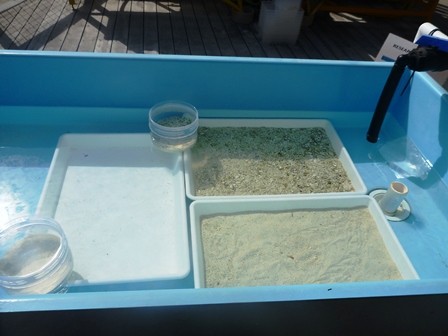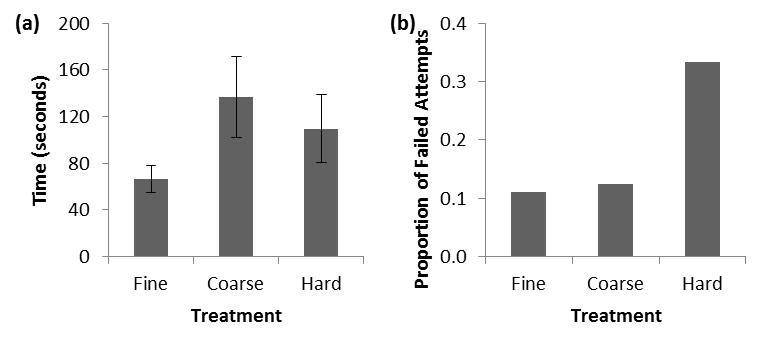Introduction
Please refer to the “Locomotion” and “Shell Righting” pages for a detailed background of these aspects of Lentigo lentiginosus behaviour. The aim of this experiment was to test how L. lentiginosus responds to different substrates when performing locomotion or when righting itself. Namely, does it take longer to move across or right itself on smooth or hard substrates or in response to coarseness of different sediments.
Methods
Live specimens were collected the northern side of the Heron Island lagoon in late September 2013. The specimens were located on the reef flat adjacent to the reef crest. Two individuals were identified in close proximity to one another and further investigation revealed no further specimens. The specimens were taken back to the research station and maintained in saltwater aquaria for five days whilst the experiment was conducted. Further collection attempts were carried out over the following days in different areas around the island without success.

Image of reef crest location at Heron Island where samples were collected in September 2013 (image courtesy of Marine Invertebrates class).
The experiment utilised three different treatment substrates: hard smooth surface, coarse rough surface and fine sediment surface. Both specimens were subjected to all treatments with a randomised order. The treatments were set up by sifting sand through a 8 tiered sand sieve to separate the coarser particles from the finer particles. The three finest grains were combined for the fine sediment treatment and the 2 coarsest grains were placed together for the coarse grain treatment. The third treatment consisted of an empty tray to provide a hard smooth surface.

Image of experimental set up of the three treatments in a salt water bath at the Heron Island Research Station (Photographer: Asia Armstrong).
For each substrate treatment the specimens were subjected to two tests: shell righting and locomotion. For the shell righting test, the strombid was placed on the dorsal side of its shell, to simulate the circumstances occurring if the snail were overturned naturally, and the time taken to right itself was recorded. Intention movements, whereby the foot is protruded and then retracted again, were also recorded. For the locomotion test, the strombid was then moved to the corner of the tray and the number of leaps and the distance covered in centimetres was recorded. These tests were conducted over a two day period on both specimens with at least one hour rest in between each trial, for a total of 8 trials per treatment. At the completion of the experiment the animals were returned to a section of the reef crest on the north of the island.
Results
On average, the strombids took longer to right themselves on the coarse substrate than on either the hard or fine substrates (figure 1a). This apparent difference was not significant (p>0.05). As a proportion, the number of failed attempts on the hard substrate was more than double that on either the fine or coarse substrates (figure 1b).

Figure 1. Shell righting attempts for Lentigo lentiginosus when the animal was placed on its dorsal surface on three different substrates: fine sediment, coarse sediment and hard surface. (a) Time taken in seconds for the animal to right itself and (b) Proportion of failed righting attempts. Error bars represent standard error.
There was no significant difference in the distance covered per leap between the three treatments (p>0.05, figure 2). There is a trend towards higher distance covered on the hard substrate, however our trials failed to show this statistically.

Figure 2. Locomotion response of Lentigo lentiginosus to three different substrates: fine sediment, coarse sediment and hard surface. Response is measured as distance in centimetres per leap. Error bars represent standard error.
Discussion
The outcome of this experiment needs to be taken with caution given the very low sample size. Ideally future research would involve a sample size of at least 10 individuals, and preferably would involve juvenile and adult specimens given the observed differences in their behaviour from previous studies (Berg 1974; Perron 1978). Given there was a possible trend towards higher distance covered per leap on the smooth and hard surface, it would also be useful to examine whether the strombids utilise different locomotry styles (ie. push vs pull) on the different substrate types as previously suggested (Berg 1974). Despite the hard surface potentially providing a better purchase for locomotion, it appeared to disadvantage the strombids in shell righting, with higher proportions of failed attempts observed for this treatment. This potentially indicates a trade off in the suitability of the substrates depending on the activity the strombid is involved in. In future studies it would be useful to note the orientation of the operculum kick for the failed attempts to see if there is a pattern for which side results in successful righting of the animal as in previous studies (Berg 1974). By analysing the impact of substrate changes on the behaviour of this species we may gain insight into their response to changing environmental conditions in the future.
|